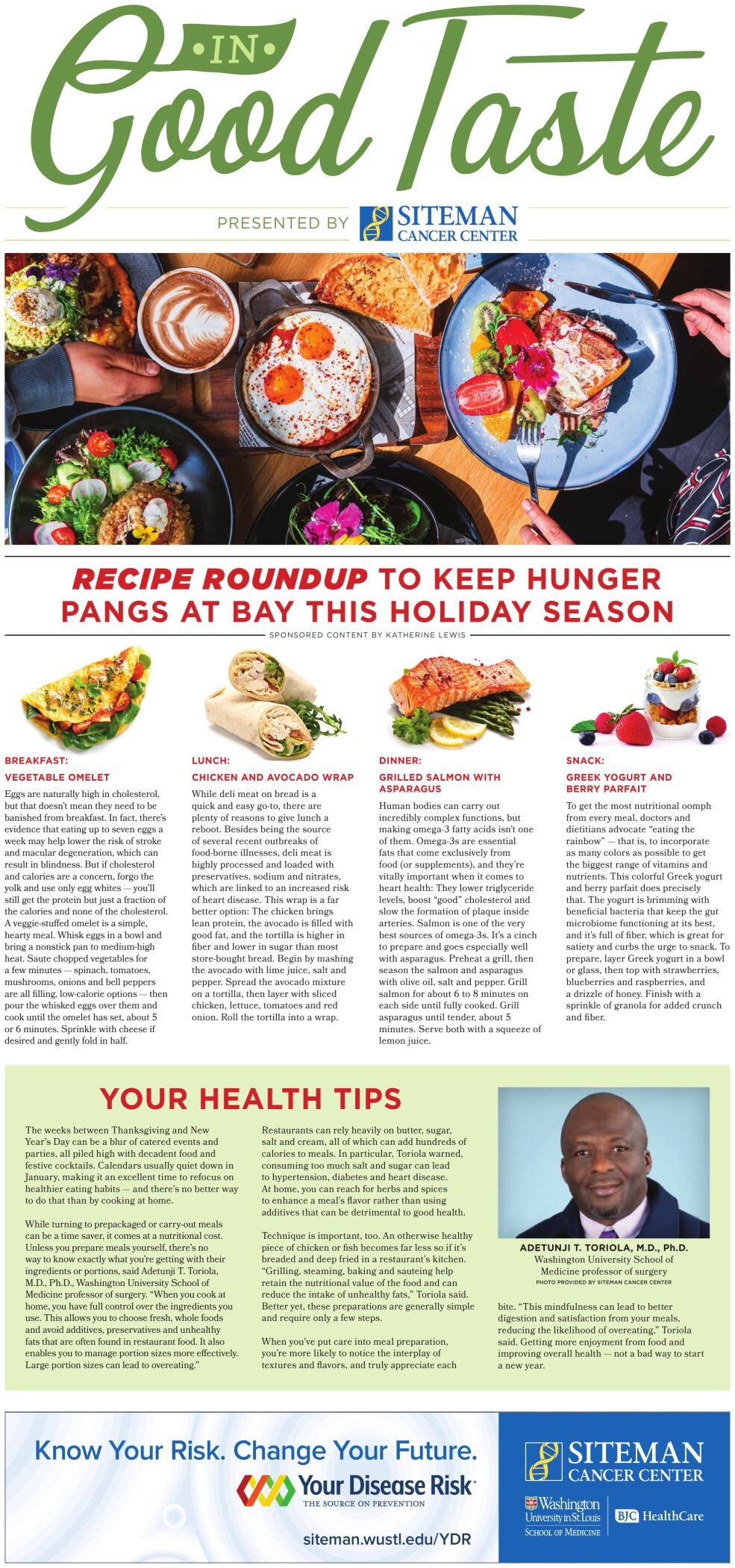BJH SITEMAN MAIN - Ad from 2024-12-29
As featured on Bjh Siteman Main
Details for BJH SITEMAN MAIN - Ad from 2024-12-29
+1(314)454-5144
PRESENTED BY
RECIPE ROUNDUP TO KEEP HUNGER
PANGS AT BAY THIS HOLIDAY SEASON
SPONSORED CONTENT BY KATHERINE LEWIS
BREAKFAST:
LUNCH:
DINNER:
SNACK:
VEGETABLE OMELET
CHICKEN AND AVOCADO WRAP
Eggs are naturally high in cholesterol,
but that doesn’t mean they need to be
banished from breakfast. In fact, there’s
evidence that eating up to seven eggs a
week may help lower the risk of stroke
and macular degeneration, which can
result in blindness. But if cholesterol
and calories are a concern, forgo the
yolk and use only egg whites — you’ll
still get the protein but just a fraction of
the calories and none of the cholesterol.
A veggie-stuffed omelet is a simple,
hearty meal. Whisk eggs in a bowl and
bring a nonstick pan to medium-high
heat. Saute chopped vegetables for
a few minutes — spinach, tomatoes,
mushrooms, onions and bell peppers
are all filling, low-calorie options — then
pour the whisked eggs over them and
cook until the omelet has set, about 5
or 6 minutes. Sprinkle with cheese if
desired and gently fold in half.
While deli meat on bread is a
quick and easy go-to, there are
plenty of reasons to give lunch a
reboot. Besides being the source
of several recent outbreaks of
food-borne illnesses, deli meat is
highly processed and loaded with
preservatives, sodium and nitrates,
which are linked to an increased risk
of heart disease. This wrap is a far
better option: The chicken brings
lean protein, the avocado is filled with
good fat, and the tortilla is higher in
fiber and lower in sugar than most
store-bought bread. Begin by mashing
the avocado with lime juice, salt and
pepper. Spread the avocado mixture
on a tortilla, then layer with sliced
chicken, lettuce, tomatoes and red
onion. Roll the tortilla into a wrap.
GRILLED SALMON WITH
ASPARAGUS
GREEK YOGURT AND
BERRY PARFAIT
Human bodies can carry out
incredibly complex functions, but
making omega-3 fatty acids isn’t one
of them. Omega-3s are essential
fats that come exclusively from
food (or supplements), and they’re
vitally important when it comes to
heart health: They lower triglyceride
levels, boost “good” cholesterol and
slow the formation of plaque inside
arteries. Salmon is one of the very
best sources of omega-3s. It’s a cinch
to prepare and goes especially well
with asparagus. Preheat a grill, then
season the salmon and asparagus
with olive oil, salt and pepper. Grill
salmon for about 6 to 8 minutes on
each side until fully cooked. Grill
asparagus until tender, about 5
minutes. Serve both with a squeeze of
lemon juice.
To get the most nutritional oomph
from every meal, doctors and
dietitians advocate “eating the
rainbow” — that is, to incorporate
as many colors as possible to get
the biggest range of vitamins and
nutrients. This colorful Greek yogurt
and berry parfait does precisely
that. The yogurt is brimming with
beneficial bacteria that keep the gut
microbiome functioning at its best,
and it’s full of fiber, which is great for
satiety and curbs the urge to snack. To
prepare, layer Greek yogurt in a bowl
or glass, then top with strawberries,
blueberries and raspberries, and
a drizzle of honey. Finish with a
sprinkle of granola for added crunch
and fiber.
YOUR HEALTH TIPS
The weeks between Thanksgiving and New
Year’s Day can be a blur of catered events and
parties, all piled high with decadent food and
festive cocktails. Calendars usually quiet down in
January, making it an excellent time to refocus on
healthier eating habits — and there’s no better way
to do that than by cooking at home.
While turning to prepackaged or carry-out meals
can be a time saver, it comes at a nutritional cost.
Unless you prepare meals yourself, there’s no
way to know exactly what you’re getting with their
ingredients or portions, said Adetunji T. Toriola,
M.D., Ph.D., Washington University School of
Medicine professor of surgery. “When you cook at
home, you have full control over the ingredients you
use. This allows you to choose fresh, whole foods
and avoid additives, preservatives and unhealthy
fats that are often found in restaurant food. It also
enables you to manage portion sizes more effectively.
Large portion sizes can lead to overeating.”
Restaurants can rely heavily on butter, sugar,
salt and cream, all of which can add hundreds of
calories to meals. In particular, Toriola warned,
consuming too much salt and sugar can lead
to hypertension, diabetes and heart disease.
At home, you can reach for herbs and spices
to enhance a meal’s flavor rather than using
additives that can be detrimental to good health.
Technique is important, too. An otherwise healthy
piece of chicken or fish becomes far less so if it’s
breaded and deep fried in a restaurant’s kitchen.
“Grilling, steaming, baking and sauteing help
retain the nutritional value of the food and can
reduce the intake of unhealthy fats,” Toriola said.
Better yet, these preparations are generally simple
and require only a few steps.
When you’ve put care into meal preparation,
you’re more likely to notice the interplay of
textures and flavors, and truly appreciate each
Know Your Risk. Change Your Future.
siteman.wustl.edu/YDR
ADETUNJI T. TORIOLA, M.D., Ph.D.
Washington University School of
Medicine professor of surgery
PHOTO PROVIDED BY SITEMAN CANCER CENTER
bite. “This mindfulness can lead to better
digestion and satisfaction from your meals,
reducing the likelihood of overeating,” Toriola
said. Getting more enjoyment from food and
improving overall health — not a bad way to start
a new year.



